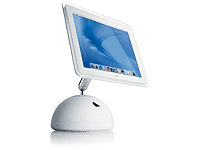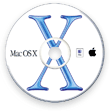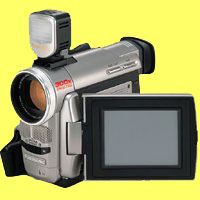Things we like
The new iMac. Ooh. Aah.

Well, they did it again. Early this year, Apple CEO Steve Jobs unveiled the new iMac — redesigned from the ground up to be the kind of computer we've never seen before.
That dome on the bottom is the computer itself, with a hard drive, various ports, an optical drive (your choice: CD/DVD, CD burner, or the SuperDrive — which burns CDs and DVDs) and a fast little video card.
That video card drives the monitor — but it's not the hulking cathode ray tube we've all been used to. Instead, an LCD screen seemingly floats in mid-air, suspended at the end of an arm that lets you adjust it at the touch of a finger.
It has the same liability as its older, less powerful siblings: upgrading. You can replace the hard drive and increase the RAM, but forget about a better video card (or a second one, which you'll need if you want to spread your work onto a second monitor). And for us, that might be a deal-breaker.
But still. Ooh. Aah. We want.
 OS
X: Maybe you should make the jump
OS
X: Maybe you should make the jump
Changing operating systems isn't something you do lightly. In fact, it should be on those lists of high-stress life events, right up there with moving, changing jobs, having a child and driving your car into your neighbours' swimming pool. (Doing all of these at once.)
But Windows and Mac users are all facing that prospect, with major revisions to both operating systems. The climb to Windows XP is a steep one, and Microsoft customers who've wondered about using a Mac might find this is the time to make the leap. After all, if you're going to learn a whole new operating system anyway, why not make it the one you really want?
OS X (Apple would like you to pronounce that "Oh Ess Ten," by the way) has an interface that's dramatically different from previous versions of the Macintosh operating system. Dubbed "Aqua," the new interface uses transparency and the illusion of depth to convey more information to the user. Design elements look like little blobs of luminous gel; the whole thing is full-on gorgeous.
Peel back the interface, though, and you'll find something unexpected: the ultra-stable Unix operating system. For the first time, a Macintosh can genuinely multi-task; you can burn a CD while you surf the web, without experiencing a massive slowdown or turning that blank CD into a coaster. Memory management is dramatically improved as well. And when a program crashes, it doesn't take the entire system down with it; OS X keeps each program in its own little compartment.
That means system crashes are rare, and program crashes are nearly non-events (provided you back up your data). If Internet Explorer dies, you usually don't even consider restarting your Mac; instead, you just launch Explorer again and pick up where you left off.
There's a lot more that's new — graphics rendering, font handling, a galaxy of free software from the open source community. Check it out yourself at www.apple.com/macosx.
Ah-ahh... saviour of the universe!
The good folks at Macromedia never saw fit to use Queen's theme to Flash Gordon to sell the company's flagship animation software.
Too bad.
Flash, now in version 5, might not be the "saviour of the universe," as the song says.
But it's a godsend to web designers who want to offer rich, smart, snazzy animations to their sites' visitors, without forcing them to wait hours while the damn thing loads.
It's fast and easy to learn. And the newest version introduces a powerful revision of the ActionScript scripting language, making it ideal for creating games and highly interactive web site tidbits.
 Mondo
video
Mondo
video
Like many camcorders these days, the Panasonic DV910 comes with FireWire — a technology that lets you download video clips to your computer very, very quickly... and digitally.
Why does that matter? Because digital data can be copied and recopied indefinitely, without losing quality. Compare that to, say, a VHS tape. Make a copy of it, and then make a copy of that copy, and you'll find muddy sound and a lousy picture.
Digital video, on the other hand, never degrades. You get exactly the same video and audio from a first-generation copy as you do from a 10th-generation copy.
Once you download your video to the computer, you can edit it together and add effects, titles and transitions easily. Then you "print" it back to videotape — or save it as a QuickTime or RealMedia file for the web.
The upshot? You'll be seeing a lot of video clips of Sisko on this site soon. :-)